Entrepreneurship Assignment: Venture Types and Economic Analysis
VerifiedAdded on 2021/02/19
|10
|2145
|70
Report
AI Summary
This report provides a comprehensive overview of entrepreneurial ventures, including their diverse types such as small businesses, large enterprises, social enterprises, and scalable enterprises, along with their respective typologies like lifestyle and growth firms. It explores the similarities and variations among these ventures, highlighting their objectives, capital requirements, and operational scales. The report then analyzes data and statistics to illustrate the significant impact of micro and small businesses on the economy, examining trends in employment, turnover, and the number of businesses. Finally, it elucidates the importance of small businesses and start-ups in fostering social economy, emphasizing their roles in providing local services and contributing to economic growth. The report concludes by summarizing the key findings and the significance of entrepreneurship in various economic contexts.

Entrepreneurship
And
Small Business
And
Small Business
Paraphrase This Document
Need a fresh take? Get an instant paraphrase of this document with our AI Paraphraser
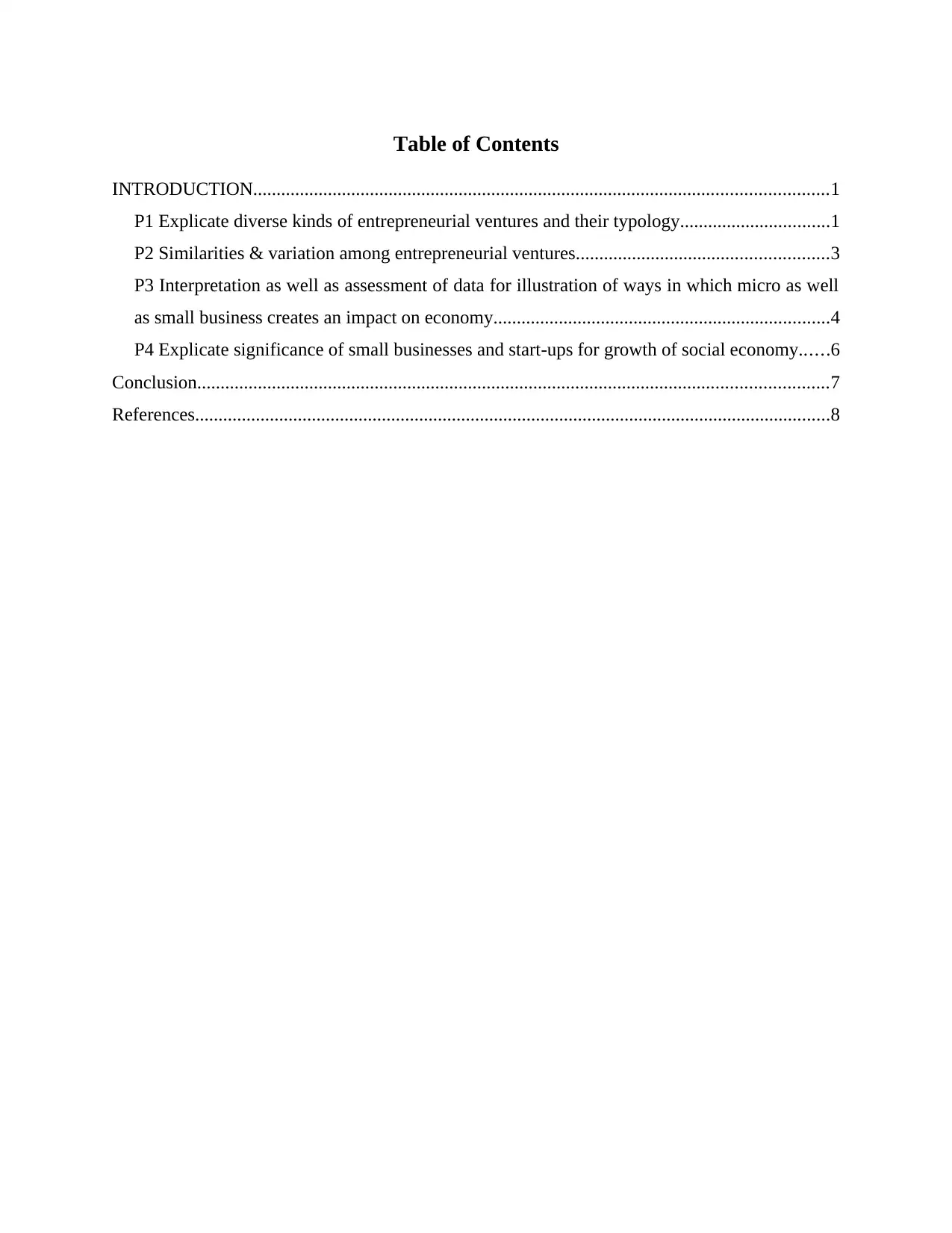
Table of Contents
INTRODUCTION...........................................................................................................................1
P1 Explicate diverse kinds of entrepreneurial ventures and their typology................................1
P2 Similarities & variation among entrepreneurial ventures......................................................3
P3 Interpretation as well as assessment of data for illustration of ways in which micro as well
as small business creates an impact on economy........................................................................4
P4 Explicate significance of small businesses and start-ups for growth of social economy......6
Conclusion.......................................................................................................................................7
References........................................................................................................................................8
INTRODUCTION...........................................................................................................................1
P1 Explicate diverse kinds of entrepreneurial ventures and their typology................................1
P2 Similarities & variation among entrepreneurial ventures......................................................3
P3 Interpretation as well as assessment of data for illustration of ways in which micro as well
as small business creates an impact on economy........................................................................4
P4 Explicate significance of small businesses and start-ups for growth of social economy......6
Conclusion.......................................................................................................................................7
References........................................................................................................................................8
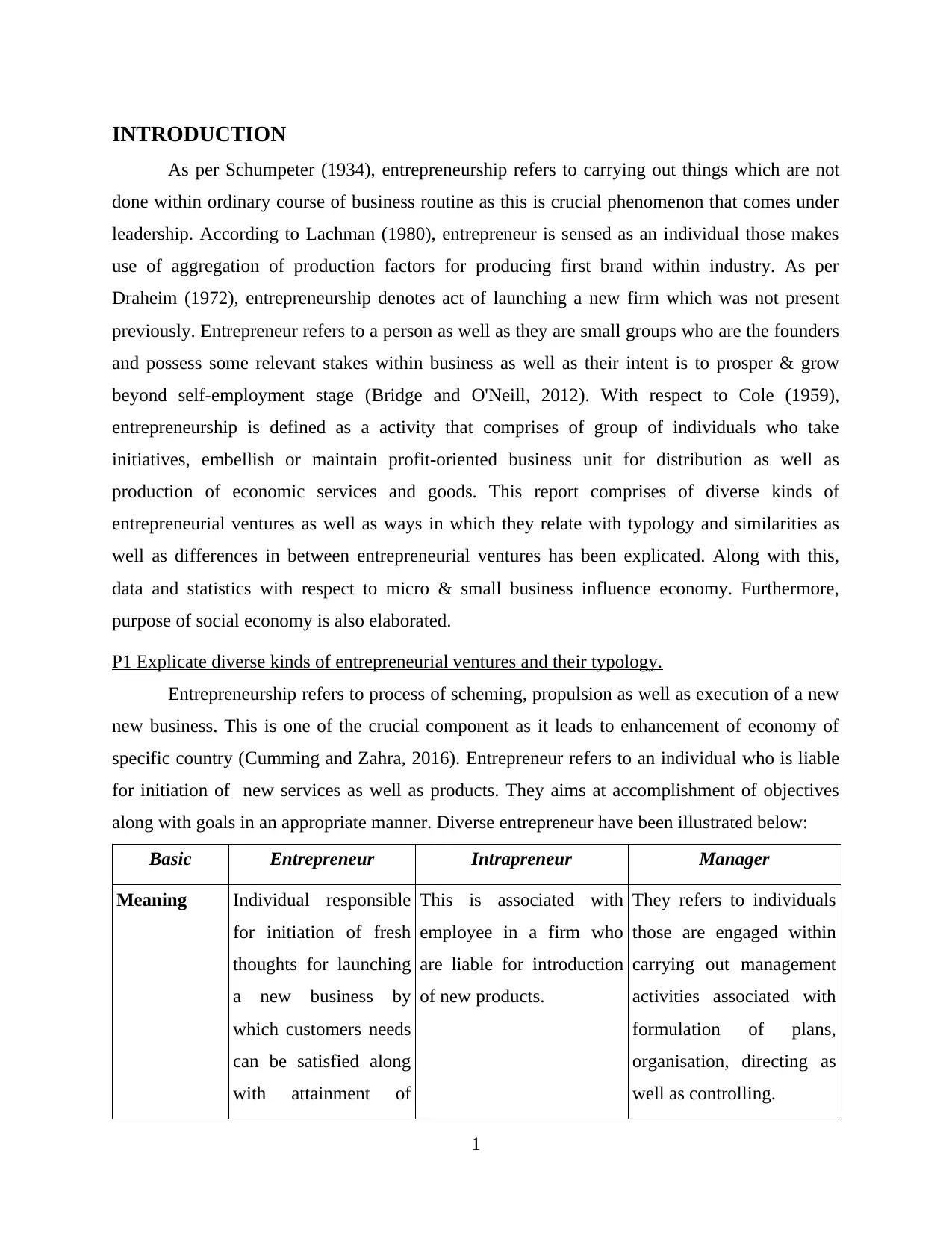
INTRODUCTION
As per Schumpeter (1934), entrepreneurship refers to carrying out things which are not
done within ordinary course of business routine as this is crucial phenomenon that comes under
leadership. According to Lachman (1980), entrepreneur is sensed as an individual those makes
use of aggregation of production factors for producing first brand within industry. As per
Draheim (1972), entrepreneurship denotes act of launching a new firm which was not present
previously. Entrepreneur refers to a person as well as they are small groups who are the founders
and possess some relevant stakes within business as well as their intent is to prosper & grow
beyond self-employment stage (Bridge and O'Neill, 2012). With respect to Cole (1959),
entrepreneurship is defined as a activity that comprises of group of individuals who take
initiatives, embellish or maintain profit-oriented business unit for distribution as well as
production of economic services and goods. This report comprises of diverse kinds of
entrepreneurial ventures as well as ways in which they relate with typology and similarities as
well as differences in between entrepreneurial ventures has been explicated. Along with this,
data and statistics with respect to micro & small business influence economy. Furthermore,
purpose of social economy is also elaborated.
P1 Explicate diverse kinds of entrepreneurial ventures and their typology.
Entrepreneurship refers to process of scheming, propulsion as well as execution of a new
new business. This is one of the crucial component as it leads to enhancement of economy of
specific country (Cumming and Zahra, 2016). Entrepreneur refers to an individual who is liable
for initiation of new services as well as products. They aims at accomplishment of objectives
along with goals in an appropriate manner. Diverse entrepreneur have been illustrated below:
Basic Entrepreneur Intrapreneur Manager
Meaning Individual responsible
for initiation of fresh
thoughts for launching
a new business by
which customers needs
can be satisfied along
with attainment of
This is associated with
employee in a firm who
are liable for introduction
of new products.
They refers to individuals
those are engaged within
carrying out management
activities associated with
formulation of plans,
organisation, directing as
well as controlling.
1
As per Schumpeter (1934), entrepreneurship refers to carrying out things which are not
done within ordinary course of business routine as this is crucial phenomenon that comes under
leadership. According to Lachman (1980), entrepreneur is sensed as an individual those makes
use of aggregation of production factors for producing first brand within industry. As per
Draheim (1972), entrepreneurship denotes act of launching a new firm which was not present
previously. Entrepreneur refers to a person as well as they are small groups who are the founders
and possess some relevant stakes within business as well as their intent is to prosper & grow
beyond self-employment stage (Bridge and O'Neill, 2012). With respect to Cole (1959),
entrepreneurship is defined as a activity that comprises of group of individuals who take
initiatives, embellish or maintain profit-oriented business unit for distribution as well as
production of economic services and goods. This report comprises of diverse kinds of
entrepreneurial ventures as well as ways in which they relate with typology and similarities as
well as differences in between entrepreneurial ventures has been explicated. Along with this,
data and statistics with respect to micro & small business influence economy. Furthermore,
purpose of social economy is also elaborated.
P1 Explicate diverse kinds of entrepreneurial ventures and their typology.
Entrepreneurship refers to process of scheming, propulsion as well as execution of a new
new business. This is one of the crucial component as it leads to enhancement of economy of
specific country (Cumming and Zahra, 2016). Entrepreneur refers to an individual who is liable
for initiation of new services as well as products. They aims at accomplishment of objectives
along with goals in an appropriate manner. Diverse entrepreneur have been illustrated below:
Basic Entrepreneur Intrapreneur Manager
Meaning Individual responsible
for initiation of fresh
thoughts for launching
a new business by
which customers needs
can be satisfied along
with attainment of
This is associated with
employee in a firm who
are liable for introduction
of new products.
They refers to individuals
those are engaged within
carrying out management
activities associated with
formulation of plans,
organisation, directing as
well as controlling.
1
⊘ This is a preview!⊘
Do you want full access?
Subscribe today to unlock all pages.

Trusted by 1+ million students worldwide
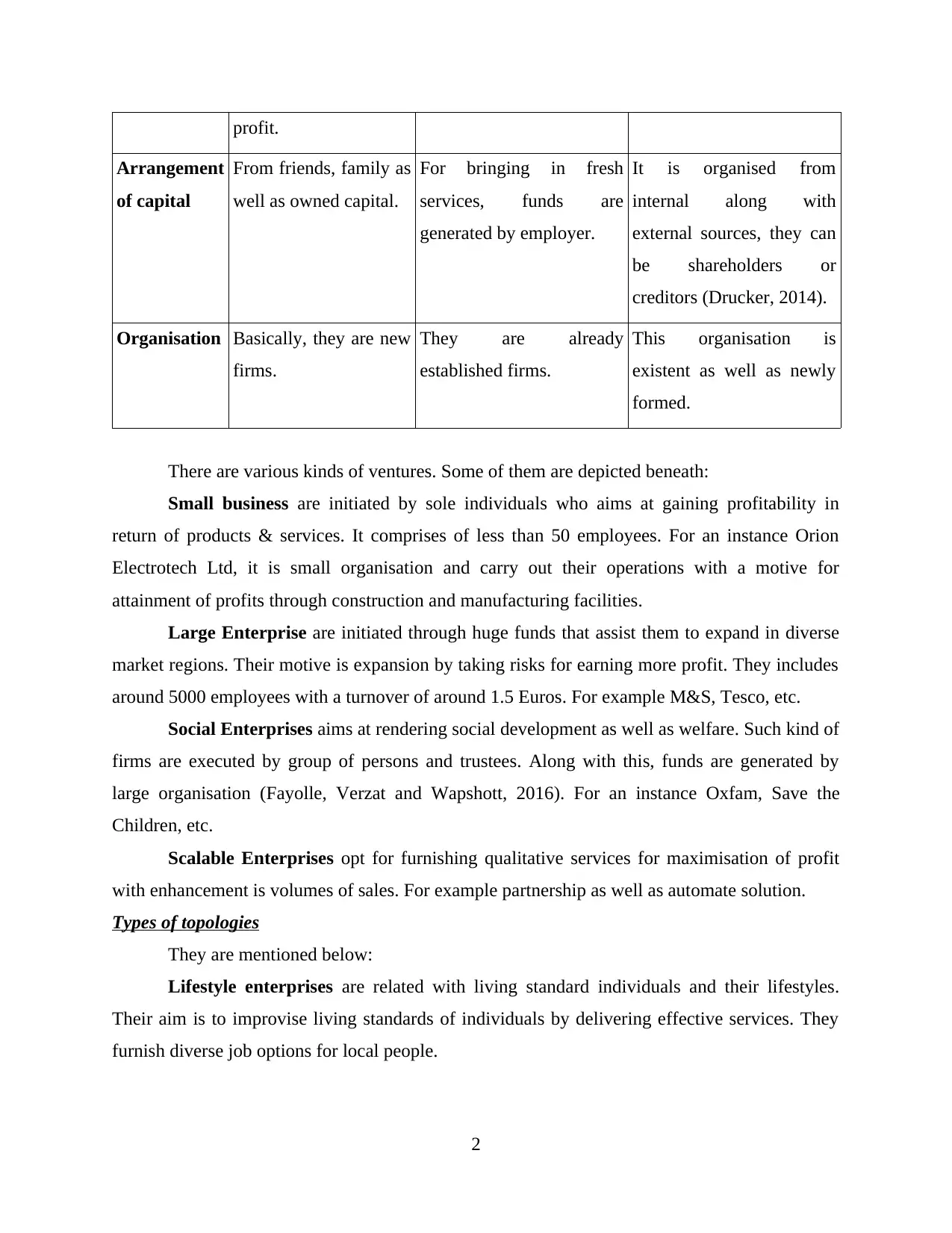
profit.
Arrangement
of capital
From friends, family as
well as owned capital.
For bringing in fresh
services, funds are
generated by employer.
It is organised from
internal along with
external sources, they can
be shareholders or
creditors (Drucker, 2014).
Organisation Basically, they are new
firms.
They are already
established firms.
This organisation is
existent as well as newly
formed.
There are various kinds of ventures. Some of them are depicted beneath:
Small business are initiated by sole individuals who aims at gaining profitability in
return of products & services. It comprises of less than 50 employees. For an instance Orion
Electrotech Ltd, it is small organisation and carry out their operations with a motive for
attainment of profits through construction and manufacturing facilities.
Large Enterprise are initiated through huge funds that assist them to expand in diverse
market regions. Their motive is expansion by taking risks for earning more profit. They includes
around 5000 employees with a turnover of around 1.5 Euros. For example M&S, Tesco, etc.
Social Enterprises aims at rendering social development as well as welfare. Such kind of
firms are executed by group of persons and trustees. Along with this, funds are generated by
large organisation (Fayolle, Verzat and Wapshott, 2016). For an instance Oxfam, Save the
Children, etc.
Scalable Enterprises opt for furnishing qualitative services for maximisation of profit
with enhancement is volumes of sales. For example partnership as well as automate solution.
Types of topologies
They are mentioned below:
Lifestyle enterprises are related with living standard individuals and their lifestyles.
Their aim is to improvise living standards of individuals by delivering effective services. They
furnish diverse job options for local people.
2
Arrangement
of capital
From friends, family as
well as owned capital.
For bringing in fresh
services, funds are
generated by employer.
It is organised from
internal along with
external sources, they can
be shareholders or
creditors (Drucker, 2014).
Organisation Basically, they are new
firms.
They are already
established firms.
This organisation is
existent as well as newly
formed.
There are various kinds of ventures. Some of them are depicted beneath:
Small business are initiated by sole individuals who aims at gaining profitability in
return of products & services. It comprises of less than 50 employees. For an instance Orion
Electrotech Ltd, it is small organisation and carry out their operations with a motive for
attainment of profits through construction and manufacturing facilities.
Large Enterprise are initiated through huge funds that assist them to expand in diverse
market regions. Their motive is expansion by taking risks for earning more profit. They includes
around 5000 employees with a turnover of around 1.5 Euros. For example M&S, Tesco, etc.
Social Enterprises aims at rendering social development as well as welfare. Such kind of
firms are executed by group of persons and trustees. Along with this, funds are generated by
large organisation (Fayolle, Verzat and Wapshott, 2016). For an instance Oxfam, Save the
Children, etc.
Scalable Enterprises opt for furnishing qualitative services for maximisation of profit
with enhancement is volumes of sales. For example partnership as well as automate solution.
Types of topologies
They are mentioned below:
Lifestyle enterprises are related with living standard individuals and their lifestyles.
Their aim is to improvise living standards of individuals by delivering effective services. They
furnish diverse job options for local people.
2
Paraphrase This Document
Need a fresh take? Get an instant paraphrase of this document with our AI Paraphraser
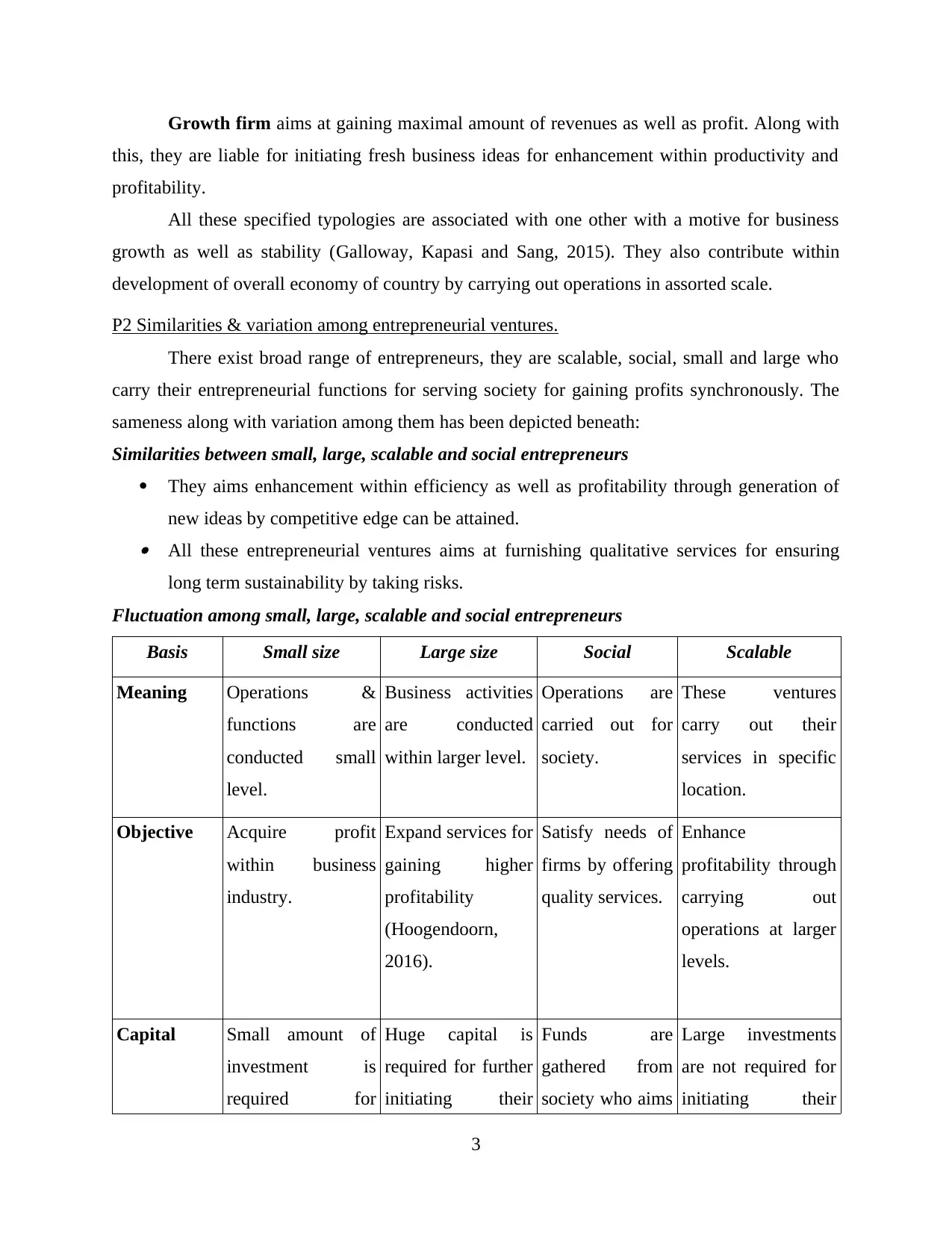
Growth firm aims at gaining maximal amount of revenues as well as profit. Along with
this, they are liable for initiating fresh business ideas for enhancement within productivity and
profitability.
All these specified typologies are associated with one other with a motive for business
growth as well as stability (Galloway, Kapasi and Sang, 2015). They also contribute within
development of overall economy of country by carrying out operations in assorted scale.
P2 Similarities & variation among entrepreneurial ventures.
There exist broad range of entrepreneurs, they are scalable, social, small and large who
carry their entrepreneurial functions for serving society for gaining profits synchronously. The
sameness along with variation among them has been depicted beneath:
Similarities between small, large, scalable and social entrepreneurs
They aims enhancement within efficiency as well as profitability through generation of
new ideas by competitive edge can be attained. All these entrepreneurial ventures aims at furnishing qualitative services for ensuring
long term sustainability by taking risks.
Fluctuation among small, large, scalable and social entrepreneurs
Basis Small size Large size Social Scalable
Meaning Operations &
functions are
conducted small
level.
Business activities
are conducted
within larger level.
Operations are
carried out for
society.
These ventures
carry out their
services in specific
location.
Objective Acquire profit
within business
industry.
Expand services for
gaining higher
profitability
(Hoogendoorn,
2016).
Satisfy needs of
firms by offering
quality services.
Enhance
profitability through
carrying out
operations at larger
levels.
Capital Small amount of
investment is
required for
Huge capital is
required for further
initiating their
Funds are
gathered from
society who aims
Large investments
are not required for
initiating their
3
this, they are liable for initiating fresh business ideas for enhancement within productivity and
profitability.
All these specified typologies are associated with one other with a motive for business
growth as well as stability (Galloway, Kapasi and Sang, 2015). They also contribute within
development of overall economy of country by carrying out operations in assorted scale.
P2 Similarities & variation among entrepreneurial ventures.
There exist broad range of entrepreneurs, they are scalable, social, small and large who
carry their entrepreneurial functions for serving society for gaining profits synchronously. The
sameness along with variation among them has been depicted beneath:
Similarities between small, large, scalable and social entrepreneurs
They aims enhancement within efficiency as well as profitability through generation of
new ideas by competitive edge can be attained. All these entrepreneurial ventures aims at furnishing qualitative services for ensuring
long term sustainability by taking risks.
Fluctuation among small, large, scalable and social entrepreneurs
Basis Small size Large size Social Scalable
Meaning Operations &
functions are
conducted small
level.
Business activities
are conducted
within larger level.
Operations are
carried out for
society.
These ventures
carry out their
services in specific
location.
Objective Acquire profit
within business
industry.
Expand services for
gaining higher
profitability
(Hoogendoorn,
2016).
Satisfy needs of
firms by offering
quality services.
Enhance
profitability through
carrying out
operations at larger
levels.
Capital Small amount of
investment is
required for
Huge capital is
required for further
initiating their
Funds are
gathered from
society who aims
Large investments
are not required for
initiating their
3
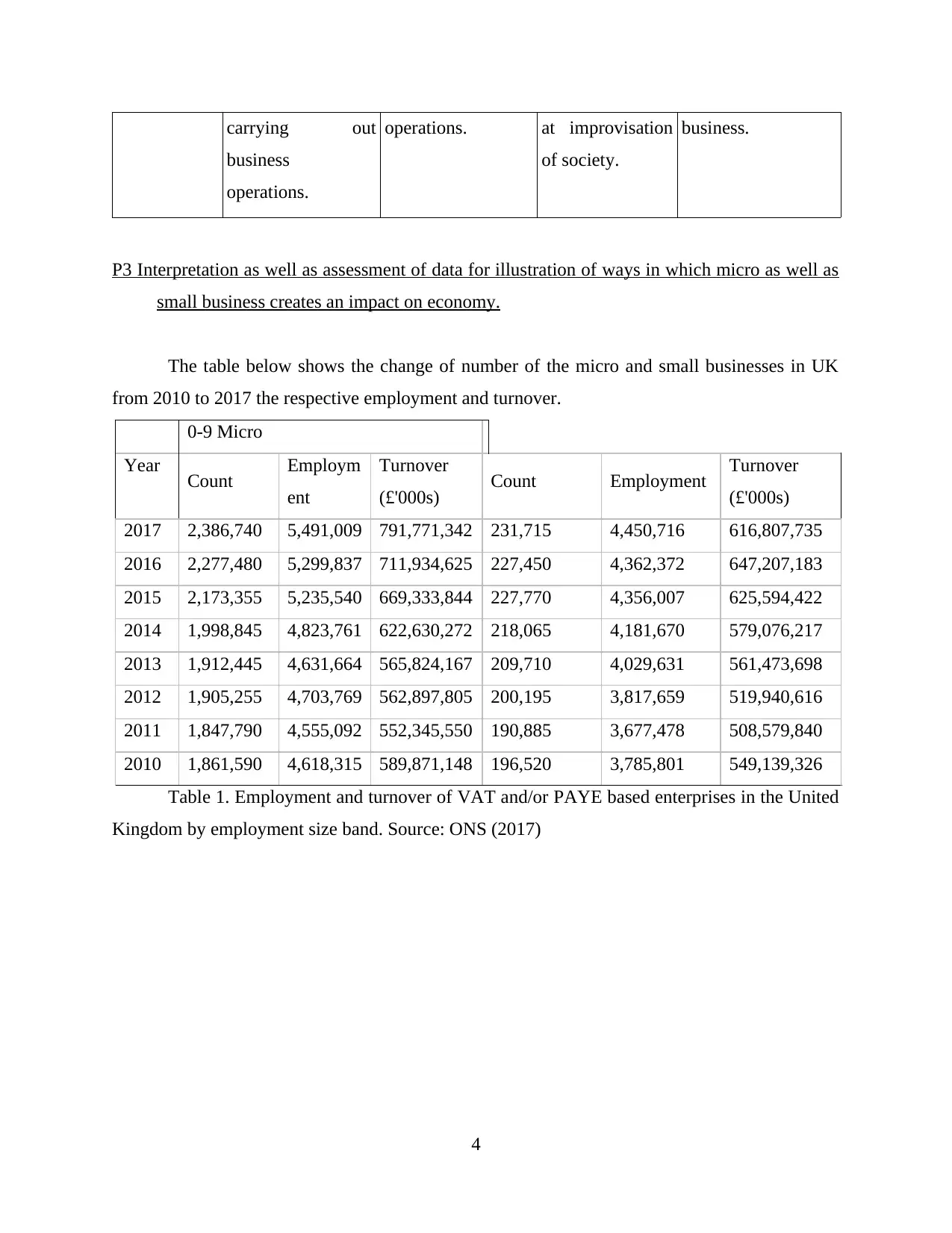
carrying out
business
operations.
operations. at improvisation
of society.
business.
P3 Interpretation as well as assessment of data for illustration of ways in which micro as well as
small business creates an impact on economy.
The table below shows the change of number of the micro and small businesses in UK
from 2010 to 2017 the respective employment and turnover.
0-9 Micro
Year Count Employm
ent
Turnover
(£'000s) Count Employment Turnover
(£'000s)
2017 2,386,740 5,491,009 791,771,342 231,715 4,450,716 616,807,735
2016 2,277,480 5,299,837 711,934,625 227,450 4,362,372 647,207,183
2015 2,173,355 5,235,540 669,333,844 227,770 4,356,007 625,594,422
2014 1,998,845 4,823,761 622,630,272 218,065 4,181,670 579,076,217
2013 1,912,445 4,631,664 565,824,167 209,710 4,029,631 561,473,698
2012 1,905,255 4,703,769 562,897,805 200,195 3,817,659 519,940,616
2011 1,847,790 4,555,092 552,345,550 190,885 3,677,478 508,579,840
2010 1,861,590 4,618,315 589,871,148 196,520 3,785,801 549,139,326
Table 1. Employment and turnover of VAT and/or PAYE based enterprises in the United
Kingdom by employment size band. Source: ONS (2017)
4
business
operations.
operations. at improvisation
of society.
business.
P3 Interpretation as well as assessment of data for illustration of ways in which micro as well as
small business creates an impact on economy.
The table below shows the change of number of the micro and small businesses in UK
from 2010 to 2017 the respective employment and turnover.
0-9 Micro
Year Count Employm
ent
Turnover
(£'000s) Count Employment Turnover
(£'000s)
2017 2,386,740 5,491,009 791,771,342 231,715 4,450,716 616,807,735
2016 2,277,480 5,299,837 711,934,625 227,450 4,362,372 647,207,183
2015 2,173,355 5,235,540 669,333,844 227,770 4,356,007 625,594,422
2014 1,998,845 4,823,761 622,630,272 218,065 4,181,670 579,076,217
2013 1,912,445 4,631,664 565,824,167 209,710 4,029,631 561,473,698
2012 1,905,255 4,703,769 562,897,805 200,195 3,817,659 519,940,616
2011 1,847,790 4,555,092 552,345,550 190,885 3,677,478 508,579,840
2010 1,861,590 4,618,315 589,871,148 196,520 3,785,801 549,139,326
Table 1. Employment and turnover of VAT and/or PAYE based enterprises in the United
Kingdom by employment size band. Source: ONS (2017)
4
⊘ This is a preview!⊘
Do you want full access?
Subscribe today to unlock all pages.

Trusted by 1+ million students worldwide
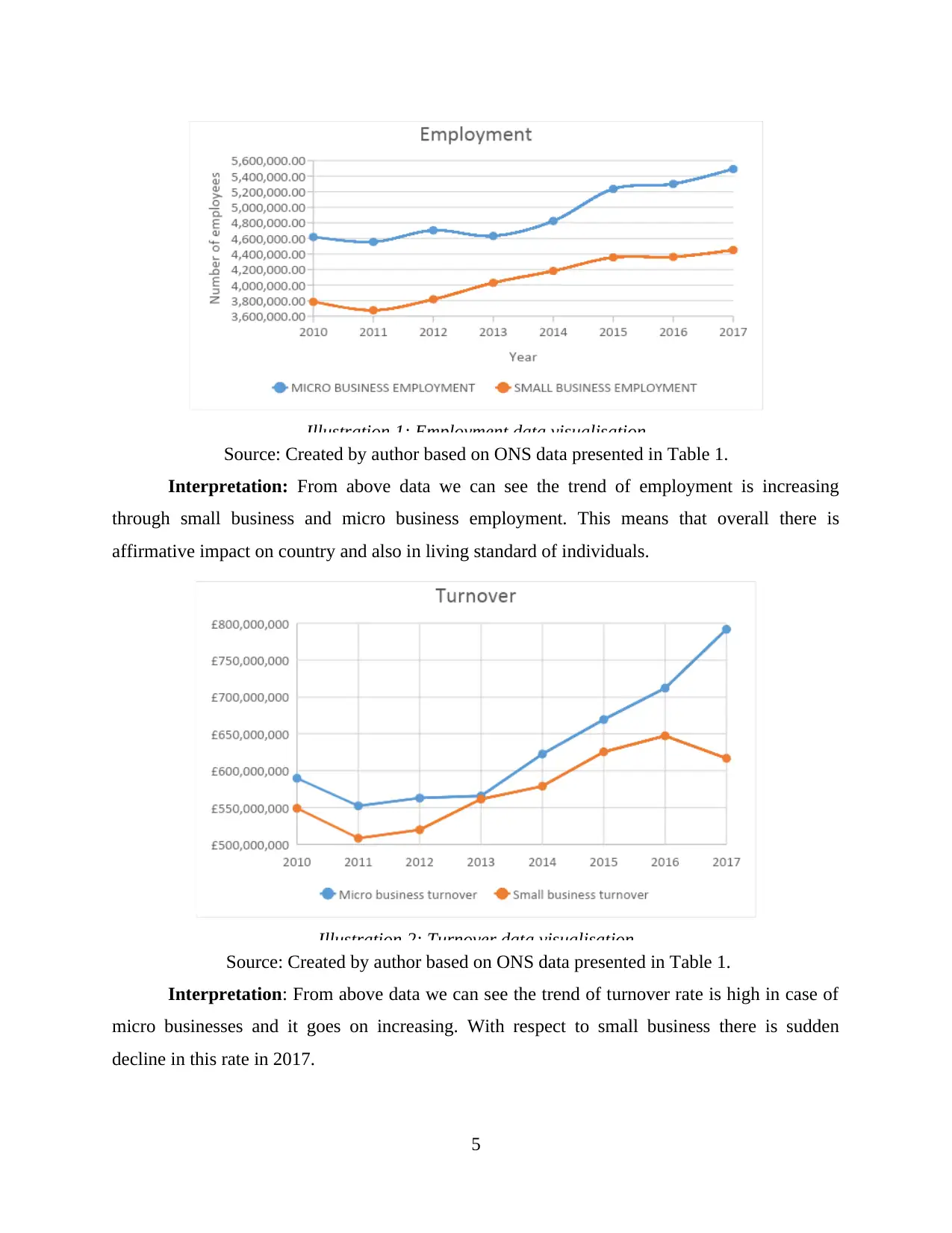
Illustration 1: Employment data visualisation
Source: Created by author based on ONS data presented in Table 1.
Interpretation: From above data we can see the trend of employment is increasing
through small business and micro business employment. This means that overall there is
affirmative impact on country and also in living standard of individuals.
Illustration 2: Turnover data visualisation
Source: Created by author based on ONS data presented in Table 1.
Interpretation: From above data we can see the trend of turnover rate is high in case of
micro businesses and it goes on increasing. With respect to small business there is sudden
decline in this rate in 2017.
5
Source: Created by author based on ONS data presented in Table 1.
Interpretation: From above data we can see the trend of employment is increasing
through small business and micro business employment. This means that overall there is
affirmative impact on country and also in living standard of individuals.
Illustration 2: Turnover data visualisation
Source: Created by author based on ONS data presented in Table 1.
Interpretation: From above data we can see the trend of turnover rate is high in case of
micro businesses and it goes on increasing. With respect to small business there is sudden
decline in this rate in 2017.
5
Paraphrase This Document
Need a fresh take? Get an instant paraphrase of this document with our AI Paraphraser
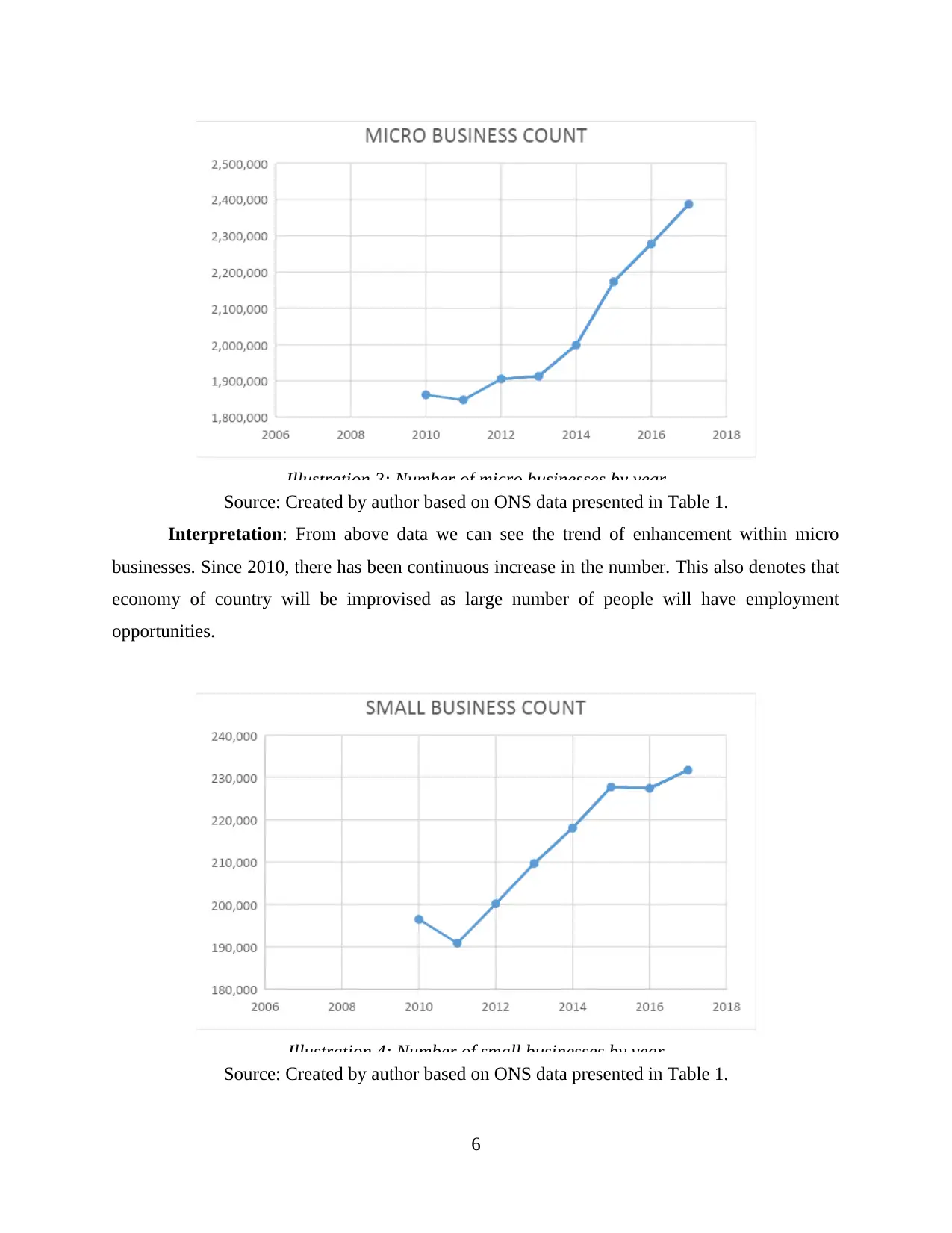
Illustration 3: Number of micro businesses by year
Source: Created by author based on ONS data presented in Table 1.
Interpretation: From above data we can see the trend of enhancement within micro
businesses. Since 2010, there has been continuous increase in the number. This also denotes that
economy of country will be improvised as large number of people will have employment
opportunities.
Illustration 4: Number of small businesses by year
Source: Created by author based on ONS data presented in Table 1.
6
Source: Created by author based on ONS data presented in Table 1.
Interpretation: From above data we can see the trend of enhancement within micro
businesses. Since 2010, there has been continuous increase in the number. This also denotes that
economy of country will be improvised as large number of people will have employment
opportunities.
Illustration 4: Number of small businesses by year
Source: Created by author based on ONS data presented in Table 1.
6
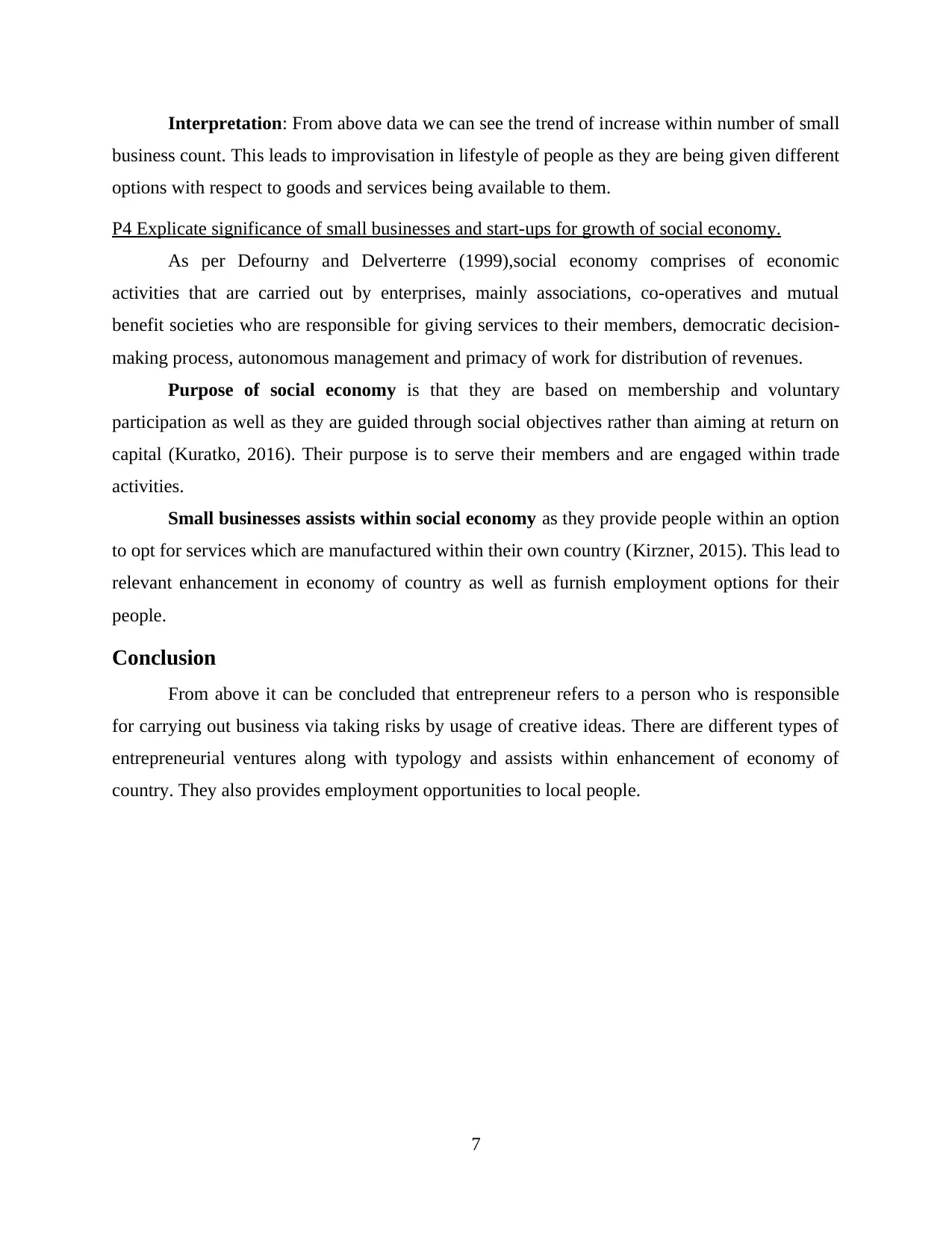
Interpretation: From above data we can see the trend of increase within number of small
business count. This leads to improvisation in lifestyle of people as they are being given different
options with respect to goods and services being available to them.
P4 Explicate significance of small businesses and start-ups for growth of social economy.
As per Defourny and Delverterre (1999),social economy comprises of economic
activities that are carried out by enterprises, mainly associations, co-operatives and mutual
benefit societies who are responsible for giving services to their members, democratic decision-
making process, autonomous management and primacy of work for distribution of revenues.
Purpose of social economy is that they are based on membership and voluntary
participation as well as they are guided through social objectives rather than aiming at return on
capital (Kuratko, 2016). Their purpose is to serve their members and are engaged within trade
activities.
Small businesses assists within social economy as they provide people within an option
to opt for services which are manufactured within their own country (Kirzner, 2015). This lead to
relevant enhancement in economy of country as well as furnish employment options for their
people.
Conclusion
From above it can be concluded that entrepreneur refers to a person who is responsible
for carrying out business via taking risks by usage of creative ideas. There are different types of
entrepreneurial ventures along with typology and assists within enhancement of economy of
country. They also provides employment opportunities to local people.
7
business count. This leads to improvisation in lifestyle of people as they are being given different
options with respect to goods and services being available to them.
P4 Explicate significance of small businesses and start-ups for growth of social economy.
As per Defourny and Delverterre (1999),social economy comprises of economic
activities that are carried out by enterprises, mainly associations, co-operatives and mutual
benefit societies who are responsible for giving services to their members, democratic decision-
making process, autonomous management and primacy of work for distribution of revenues.
Purpose of social economy is that they are based on membership and voluntary
participation as well as they are guided through social objectives rather than aiming at return on
capital (Kuratko, 2016). Their purpose is to serve their members and are engaged within trade
activities.
Small businesses assists within social economy as they provide people within an option
to opt for services which are manufactured within their own country (Kirzner, 2015). This lead to
relevant enhancement in economy of country as well as furnish employment options for their
people.
Conclusion
From above it can be concluded that entrepreneur refers to a person who is responsible
for carrying out business via taking risks by usage of creative ideas. There are different types of
entrepreneurial ventures along with typology and assists within enhancement of economy of
country. They also provides employment opportunities to local people.
7
⊘ This is a preview!⊘
Do you want full access?
Subscribe today to unlock all pages.

Trusted by 1+ million students worldwide
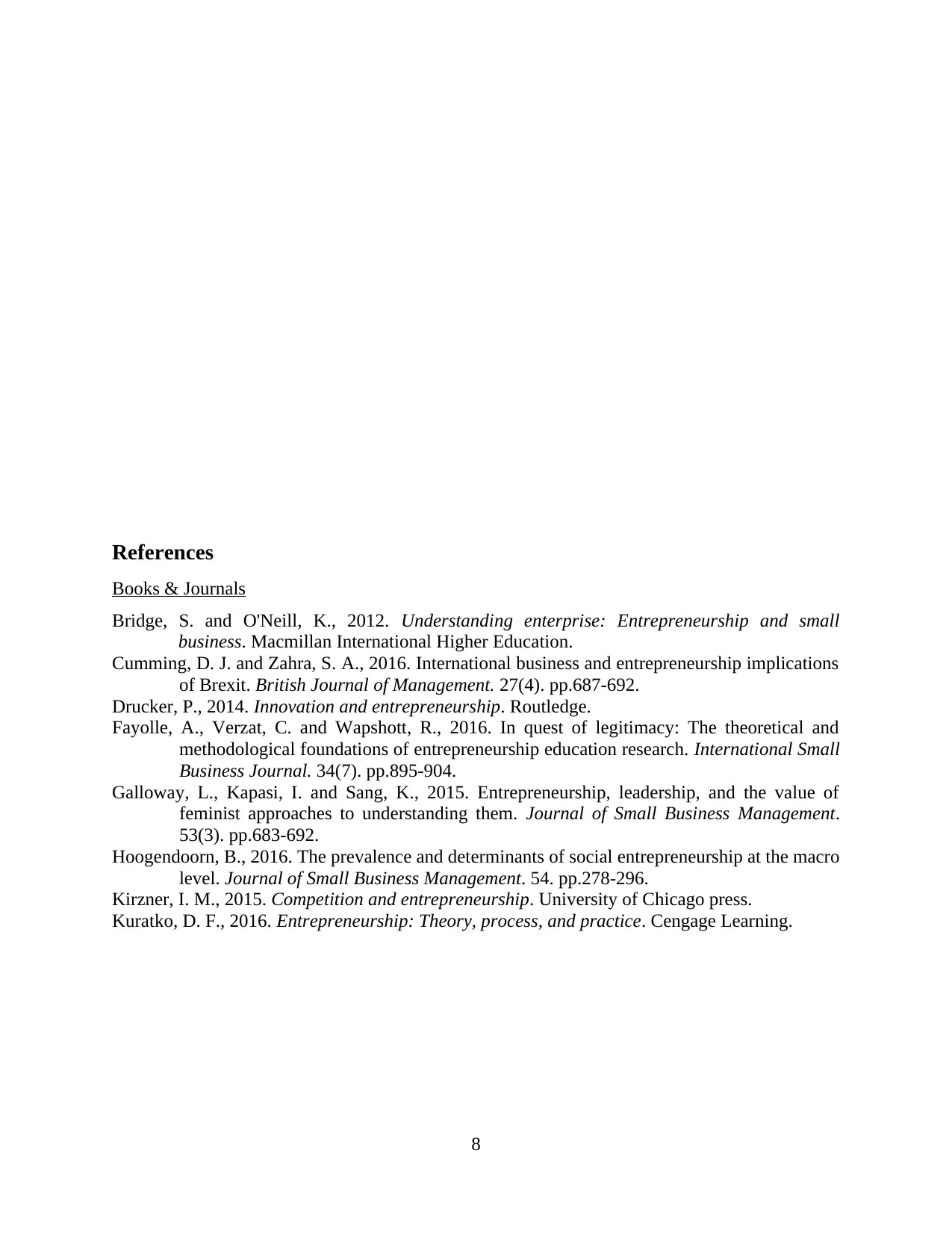
References
Books & Journals
Bridge, S. and O'Neill, K., 2012. Understanding enterprise: Entrepreneurship and small
business. Macmillan International Higher Education.
Cumming, D. J. and Zahra, S. A., 2016. International business and entrepreneurship implications
of Brexit. British Journal of Management. 27(4). pp.687-692.
Drucker, P., 2014. Innovation and entrepreneurship. Routledge.
Fayolle, A., Verzat, C. and Wapshott, R., 2016. In quest of legitimacy: The theoretical and
methodological foundations of entrepreneurship education research. International Small
Business Journal. 34(7). pp.895-904.
Galloway, L., Kapasi, I. and Sang, K., 2015. Entrepreneurship, leadership, and the value of
feminist approaches to understanding them. Journal of Small Business Management.
53(3). pp.683-692.
Hoogendoorn, B., 2016. The prevalence and determinants of social entrepreneurship at the macro
level. Journal of Small Business Management. 54. pp.278-296.
Kirzner, I. M., 2015. Competition and entrepreneurship. University of Chicago press.
Kuratko, D. F., 2016. Entrepreneurship: Theory, process, and practice. Cengage Learning.
8
Books & Journals
Bridge, S. and O'Neill, K., 2012. Understanding enterprise: Entrepreneurship and small
business. Macmillan International Higher Education.
Cumming, D. J. and Zahra, S. A., 2016. International business and entrepreneurship implications
of Brexit. British Journal of Management. 27(4). pp.687-692.
Drucker, P., 2014. Innovation and entrepreneurship. Routledge.
Fayolle, A., Verzat, C. and Wapshott, R., 2016. In quest of legitimacy: The theoretical and
methodological foundations of entrepreneurship education research. International Small
Business Journal. 34(7). pp.895-904.
Galloway, L., Kapasi, I. and Sang, K., 2015. Entrepreneurship, leadership, and the value of
feminist approaches to understanding them. Journal of Small Business Management.
53(3). pp.683-692.
Hoogendoorn, B., 2016. The prevalence and determinants of social entrepreneurship at the macro
level. Journal of Small Business Management. 54. pp.278-296.
Kirzner, I. M., 2015. Competition and entrepreneurship. University of Chicago press.
Kuratko, D. F., 2016. Entrepreneurship: Theory, process, and practice. Cengage Learning.
8
1 out of 10
Related Documents
Your All-in-One AI-Powered Toolkit for Academic Success.
+13062052269
info@desklib.com
Available 24*7 on WhatsApp / Email
![[object Object]](/_next/static/media/star-bottom.7253800d.svg)
Unlock your academic potential
Copyright © 2020–2025 A2Z Services. All Rights Reserved. Developed and managed by ZUCOL.





